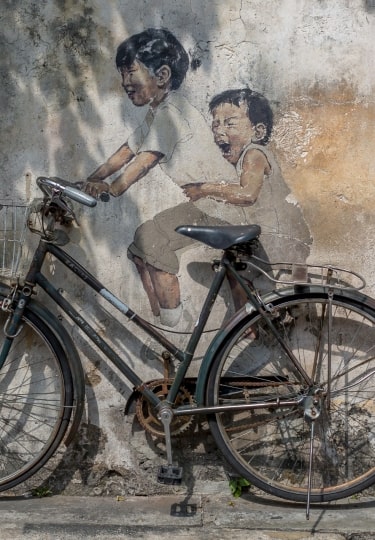Visiting the world’s most famous murals and street art will afford you an alternative insight into a destination’s current pulse. So much of traveling is focused on the historic and grand, whereas taking a moment to seek stencil art, graffiti, murals, and installations often leads to a new perspective on an old favorite.
In Europe, that might be thought-provoking graffiti plastered on history-defining walls. In Asia, you’ll find plenty of playful pieces where local artists have captured colorful, cultured scenes. And in America’s largest cities, murals are often bold, brash, and multi-layered messages which serve as stand-out attractions in their own right.
From Aruba’s international collaborations illuminating San Nicolas to Miami’s museum-level Wynwood Walls, these famous street art installations are worth traveling for.
The Fraternal Kiss, East Side Gallery, Berlin, Germany
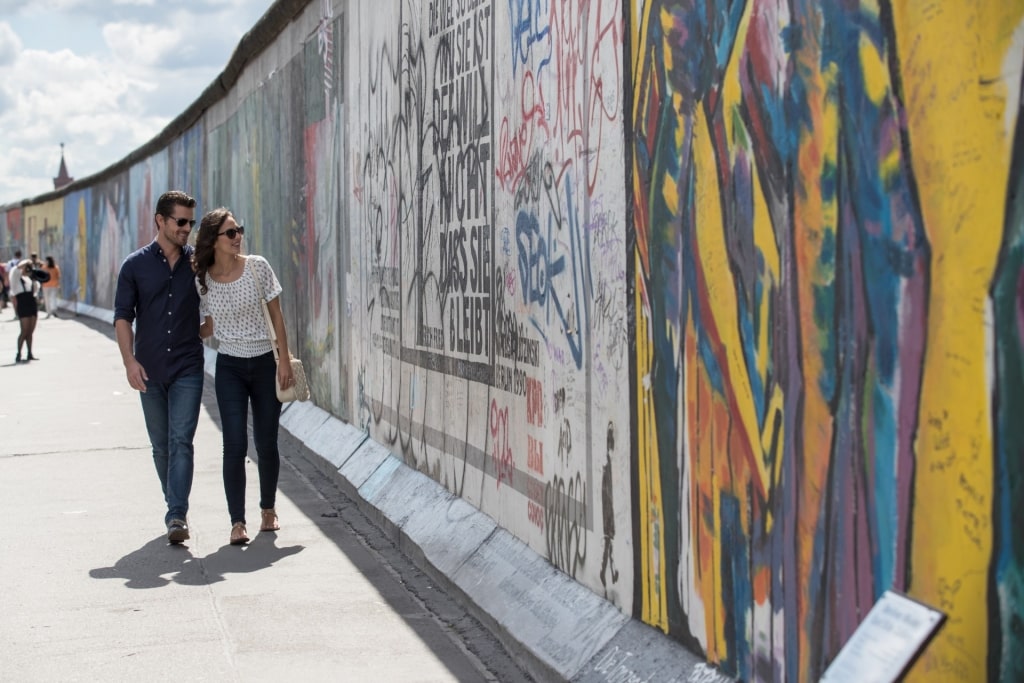
Berlin Wall, Germany
One of the world’s most famous murals, The Fraternal Kiss, or officially, My God, Help Me to Survive This Deadly Love, is almost as much of the story of Berlin as the wall it adorns.
Following the fall of the Berlin Wall in November 1989, small remnants and sections of the history-defining East and West divide were preserved in remembrance. Quickly after the reunification, murals, graffiti, and political messages were plastered across these sections, becoming symbols of the past and hopes for the future.
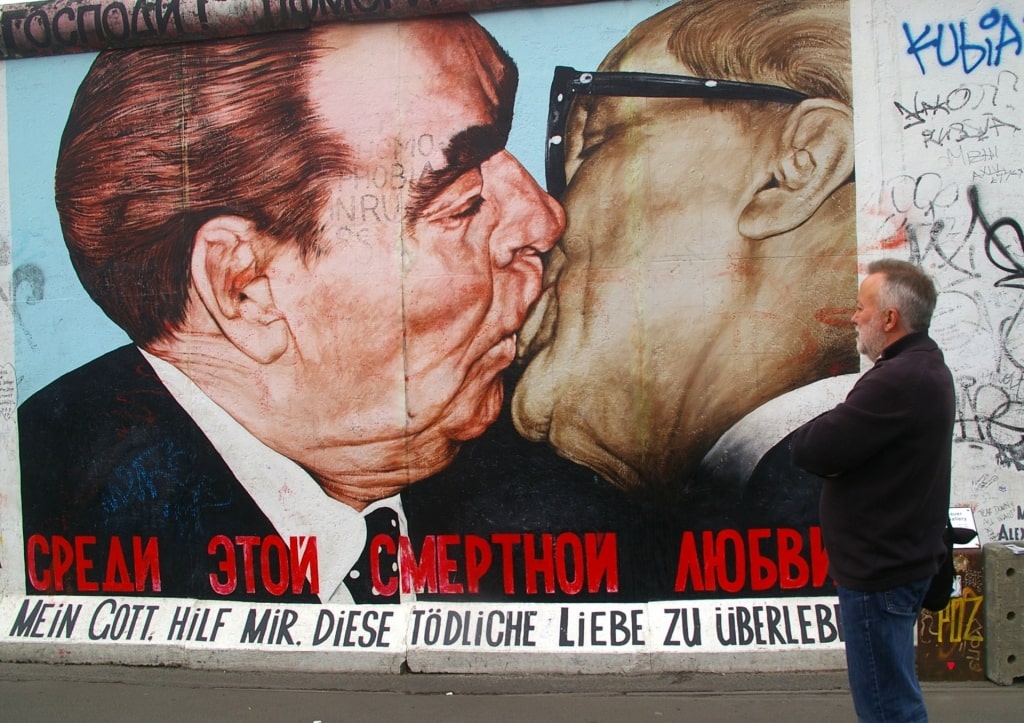
The Fraternal Kiss in Berlin, Germany Photo by Rae Allen on Flickr, licensed under CC BY 2.0
The Fraternal Kiss, painted by Dmitri Vrubel in 1990, is perhaps the wall’s best-known piece. Vrubel’s mural is a recreation of a 1979 photo, capturing Leonid Brezhnev, the former General Secretary of the Soviet Union, and Erich Honecker, former leader of the German Democratic Republic, kissing.
Just one of some 100 murals covering a 4,300-foot-long stretch of the Berlin Wall, the collection, known as the East Side Gallery, is a fascinating mix of storytelling and poignant reminders, and combined with the other areas, is now billed as the world’s largest open-air gallery.
Mural das Etnias, Rio de Janeiro, Brazil
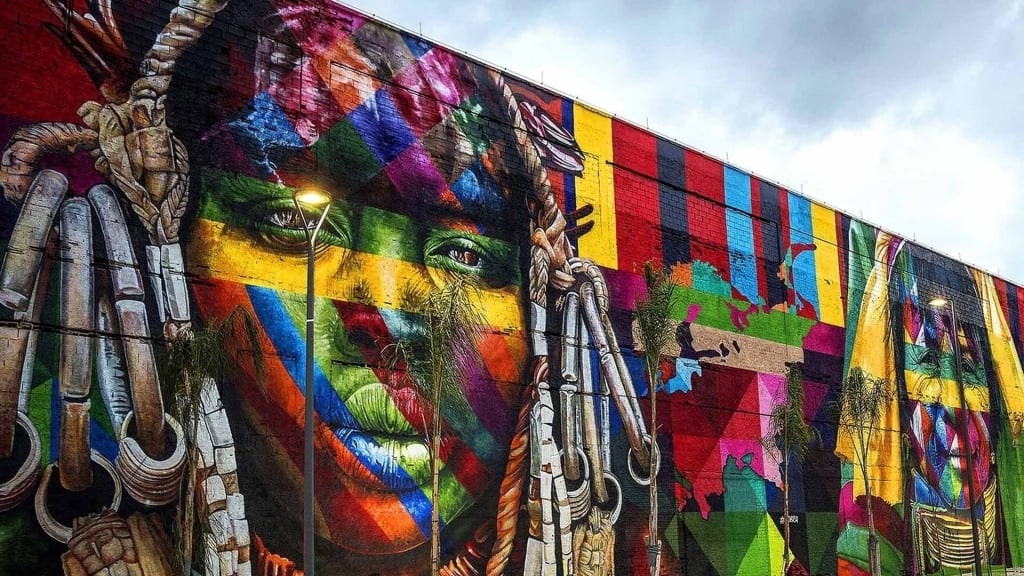
Mural das Etnias in Rio de Janeiro, Brazil Photo by Buzancar on Wikimedia Commons, licensed under CC BY-SA 4.0
Once the record holder for the world’s largest street art mural, Eduardo Kobra and his talented team painted the 560-foot long Mural das Etnias (Ethnicities), or Todos Somos Um (We Are All One), in Rio de Janeiro to honor the city hosting the 2016 Olympic Games.
Working with his equally talented team of spray painters, the kaleidoscopic, vast, and awe-inspiring work brought the faces of indigenous communities the world over to the so-called Olympic Boulevard in the city’s Port Zone.
Nearly a decade after the city’s Olympic legacy, seeing the soaring mural is still a must for any street art fan who finds themselves in Rio de Janeiro. Remaining vibrant, timely, and thought-provoking in Kobra’s signature style, the Olympic Ring-inspired mural remains one of his greatest works.
However, Kobra and his team do still hold the same world record for another piece, having outdone their previous result with an even grander mural. Dedicated to the cocoa plant, the work covers a chocolate factory in São Paulo, Brazil. The work, his 2018 title-holder, took more than 700 hours to create.
Hammer Boy, New York City, USA
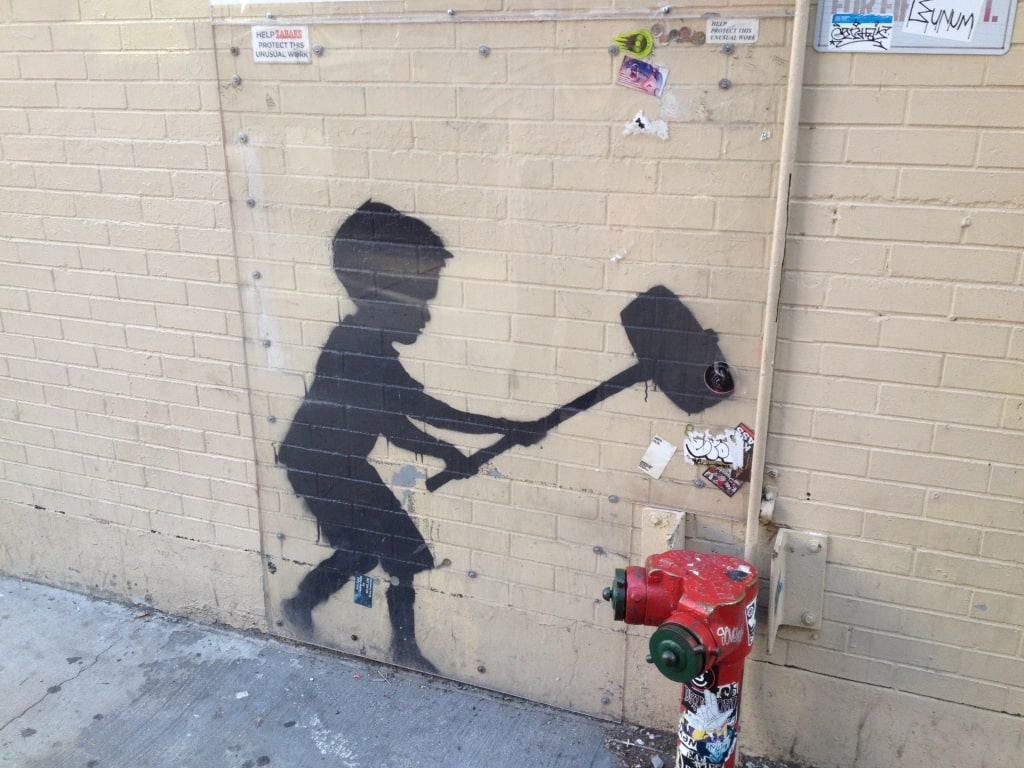
Hammer Boy in New York City, USA Photo by Miyagawa on Wikimedia Commons, licensed under CC BY-SA 4.0
Banksy is one of the most prolific and famous street artists, even with his signature incognito style. He was born and raised in Bristol, UK and the majority of his works appear in London and other major UK cities. However, a few of his most famous murals can be found in North America.
Hammer Boy, which appeared in Manhattan in 2013, is one such work. Protected by plexiglass, as sadly, many of his other pieces in New York have been painted over, the mural can be found at 79th Street in Upper West Side.
One of his more simple visions, the image shows a young boy bringing down a hammer on an already in-place fire hydrant, reminiscent of the arcade and carnival game. Banksy has left speculation of the message behind the work to the viewer, never adding official comment to the street art’s meaning.
Indigenous Boy, Hosier Lane, Melbourne, Australia
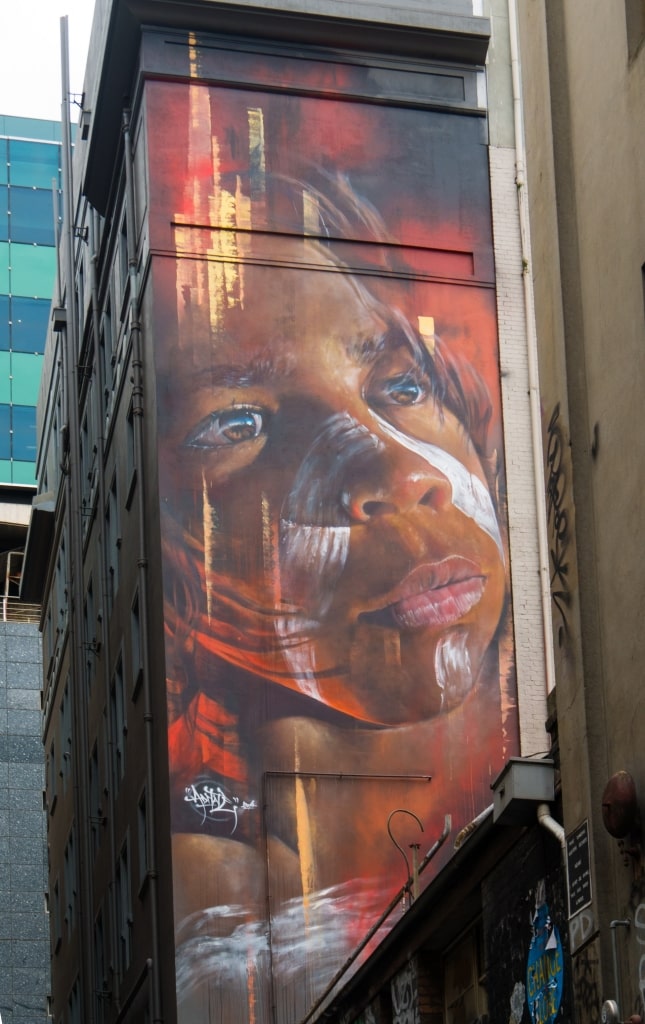
Indigenous Boy in Melbourne, Australia Photo by Jay Galvin on Flickr, licensed under CC BY 2.0
Mention famous murals to any Australian and conversation will undoubtedly turn to Hosier Lane, one of the best places to visit in Melbourne. As Melbourne’s pocket of cool, where first-class coffee and endless graffiti go hand in hand, it’s one of Australia’s art-defining spots.
While there are numerous works all blending into one along Hosier’s particularly decorated laneway, Indigenous Boy especially stands out, both for its relevance and size.
The artist, Adnate, was hand-picked in 2014 to fill a rare blank canvas—a 75-foot-high wall. The image he chose, of an Aboriginal boy, added much-needed representation of the Wurundjeri people, the Indigenous landowners of the surrounding area.
With an eye towards Birrarung Marr, a city-center park and sacred Aboriginal site along the Yarra River, the pensive and highly-detailed mural of the young man with ceremonial white face paint is one of the many must-visit murals in Melbourne.
Half Rabbit, Gaia, Porto, Portugal
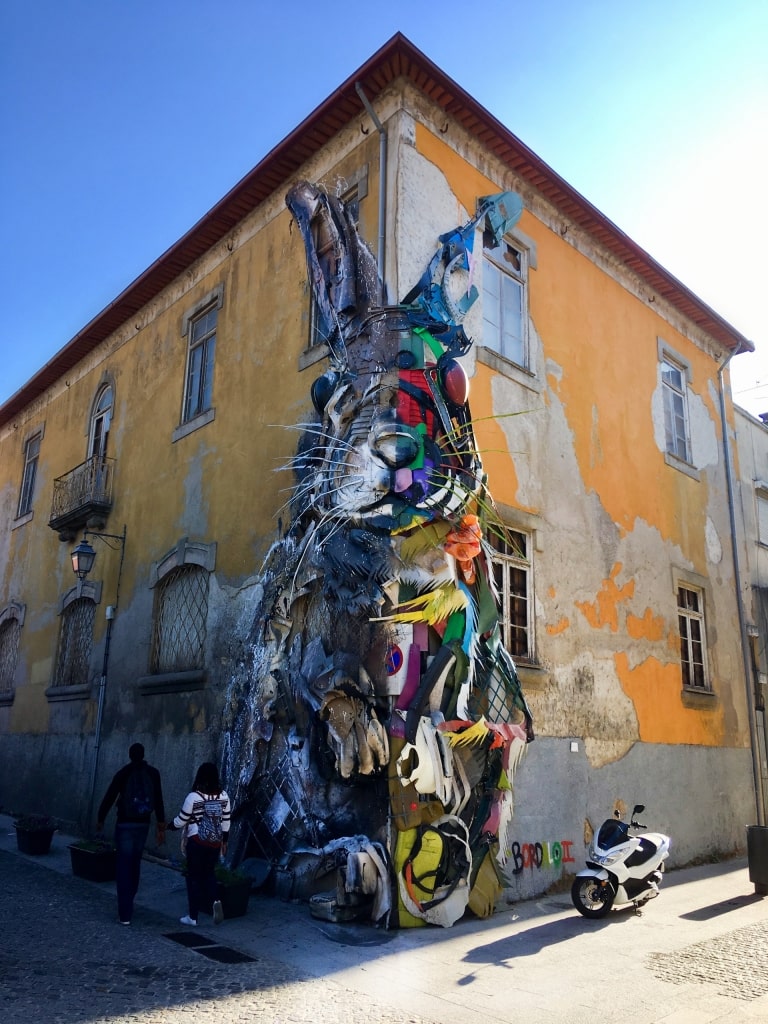
Half Rabbit in Porto, Portugal Photo by Raini Svensson on Flickr, licensed under PDM 1.0
Bordalo II, one of the most acclaimed Portuguese street artists, is renowned for his art’s messaging and use of recycled trash. No longer just celebrated on the national stage, his work can be admired from Aruba to Singapore.
Half Rabbit, located on a street corner in Gaia, across the Douro River from Porto, Portugal’s second city, is one of his earlier creations from 2007.
Part of Bordalo’s Big Trash Animals series, a body of work the artist conceived to repurpose the plastic garbage that often harms wildlife. The half color, half black-and-white design of his pieces allows the abstract, re-used plastic nature of his street art to be more visible.
Wynwood Walls, Miami, USA
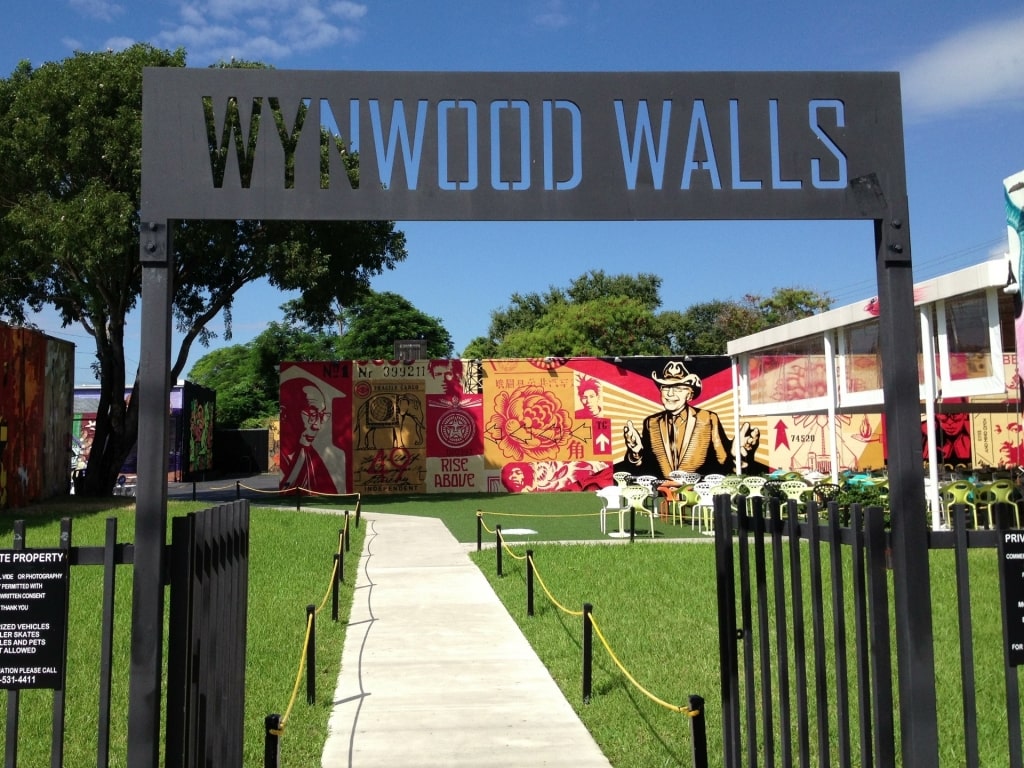
Wynwood Walls in Miami, USA Photo by Phillip Pessar on Flickr, licensed under CC BY 2.0
Highlighting the best of Wynwood Walls is nearly impossible. Unlike most other famous street art collections, the most renowned mural project in Miami is more open-air art museum than ad-hoc project. Every year, the works are elevated further, making the whole collection some of the world’s most famous street art.
While many would argue that the departure from the site’s previously free-to-access art could stifle creativity, Wynwood Walls’ mission remains to evolve continually, bringing both emerging and leading artists back to create new installations.
Some of the most famous artwork includes that of Kenny Scharf, one of LA’s most prolific muralists, and OSGEMEOS’ mural complete with their signature yellow-skinned characters and equally typical social commentary.
Kids on Bicycle, George Town, Malaysia
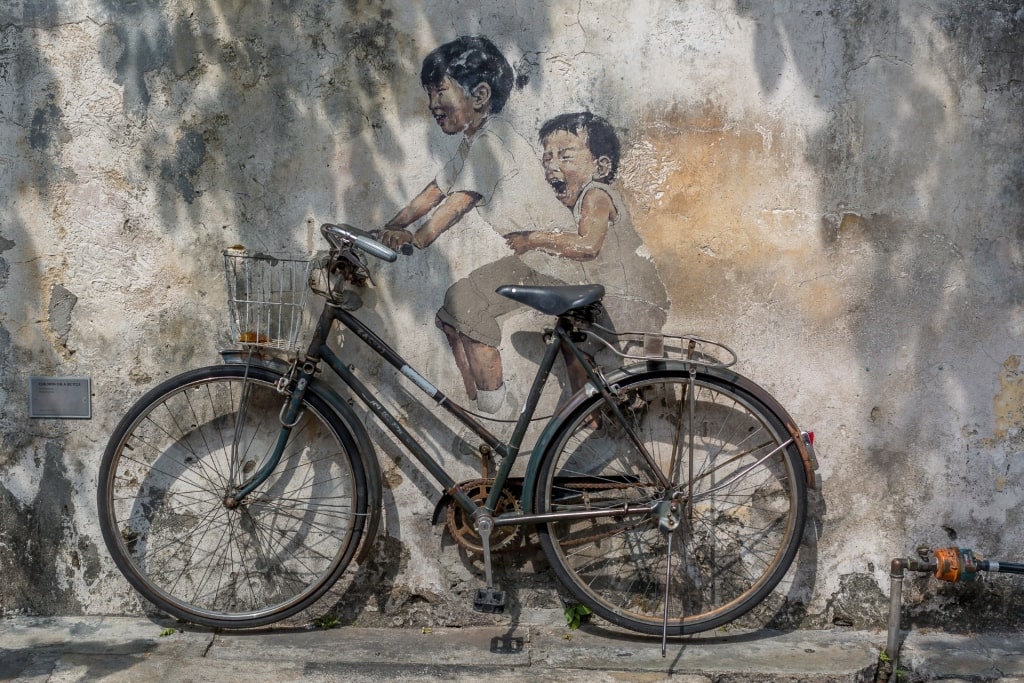
Kids on Bicycle in George Town, Malaysia
George Town, the main city on Malaysia’s Penang Island, has no shortage of quirky and colorful artwork decorating its UNESCO-listed streets. One of the most popular pieces, Kids on Bicycle, is also one of the most playful.
The work of Ernest Zacharevic, a Lithuanian street artist who has called Penang home for many years, the image of two children riding a bicycle was painted in 2012.
However, far from being just a two-dimensional artwork, Zacharevic’s idea was crafted around an actual bicycle, complete with a basket, attached to the wall.
Whether it was his intention or not, this interactive element has led to Kids on Bicycle becoming one of Asia’s most famous murals as visitors line up to take a photo perching on the seat or pushing the bike from behind. Start thinking of how to add your own creative spin to your photo before arrival.
MaestraPeace Mural, San Francisco, USA
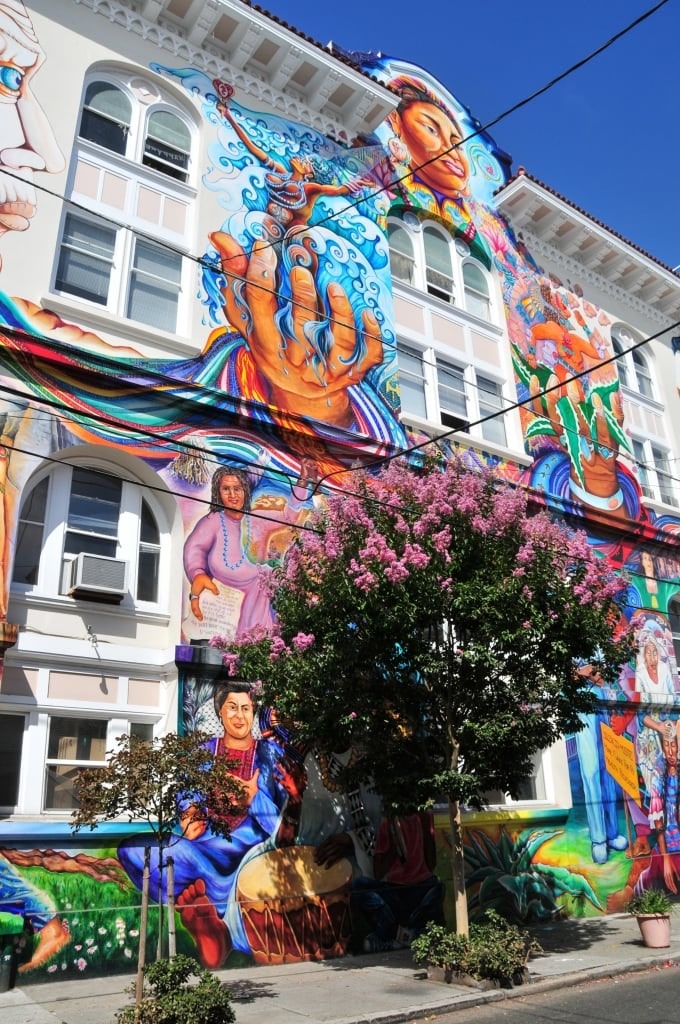
MaestraPeace Mural in San Francisco, USA Photo by John Leszczynski on Flickr, licensed under CC BY-SA 2.0
San Francisco has no shortage of street art. The Mission District, with its long-standing creative hubs such as Balmy Alley, is renowned worldwide for creative flair and influential messaging.
Yet it was the collaborative work of seven women—Juana Alicia, Miranda Bergman, Edythe Boone, Susan Kelk Cervantes, Meera Desai, Yvonne Littleton, Irene Perez—and many more volunteers that perhaps gave the city its most compelling work, the MaestraPeace Mural, translated as “woman, teacher of peace.”
The impressive and grand display, which covers both the Lapidge and 18th Street sides of The Women’s Building, a center dedicated to the well-being of women and girls, was completed in 2000.
Best known for its focus on influential women worldwide, including political prisoners, Asian and Aztec goddesses, and symbols of freedom, it’s a timeless and befitting mural for such an important space.
Freetown Christiania, Copenhagen, Denmark
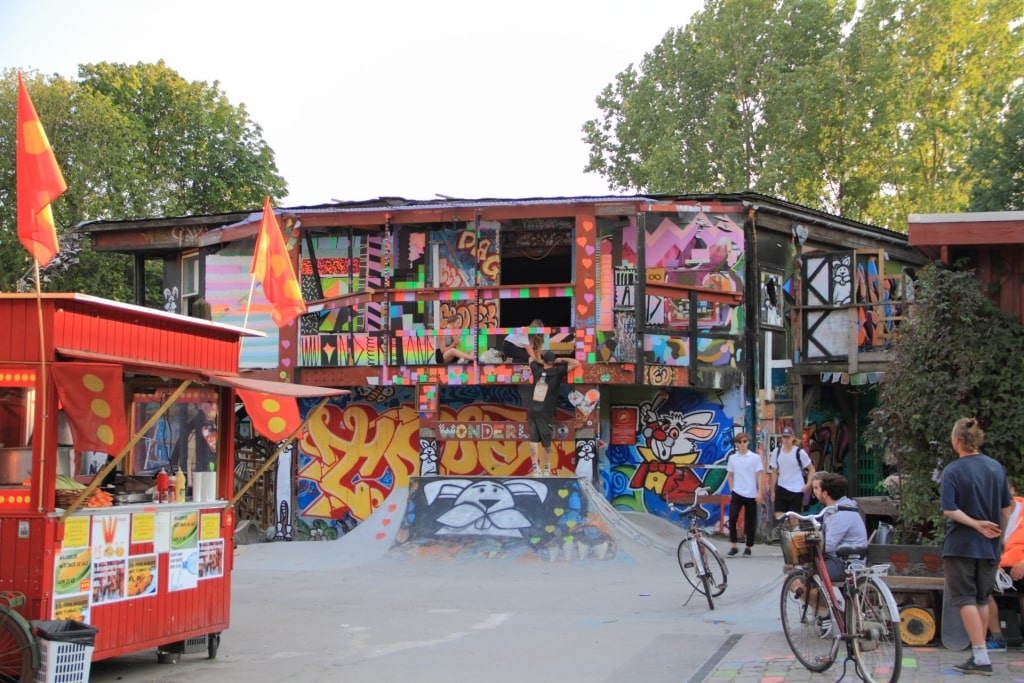
Freetown Christiania in Copenhagen, Denmark Photo by Schorle on Wikimedia Commons, licensed under CC BY-SA 4.0
A city-within-a-city in Denmark, Freetown Christiania is home to some of Scandinavia’s most famous street art. But whittling it down to a top pick is nearly impossible; normal rules don’t apply here.
Established by squatters in the 1970s, this one-time commune, which occupied a former military base, soon expanded both in size and definition, and eventually became a breakaway, self-regulated community with its own currency, flag, and set of rules.
Understandably, this set the scene for an abundance of creativity and street art. The bohemian streets, where photography is prohibited, have become a canvas for all things free-spirited, psychedelic, and positive, with murals now coating nearly every building.
To best understand Christiania and know its street art better (most works aren’t tagged, making attribution hard for an outsider) it’s advisable to join a fascinating tour led by one of the community’s 900-odd residents.
Not only will you gain insider knowledge of the murals, but you’ll leave with a better insight into how one of the continent’s most unique communities lives right in the heart of a European capital.
Read: Best Things to Do in Copenhagen
Giants, Vancouver, Canada
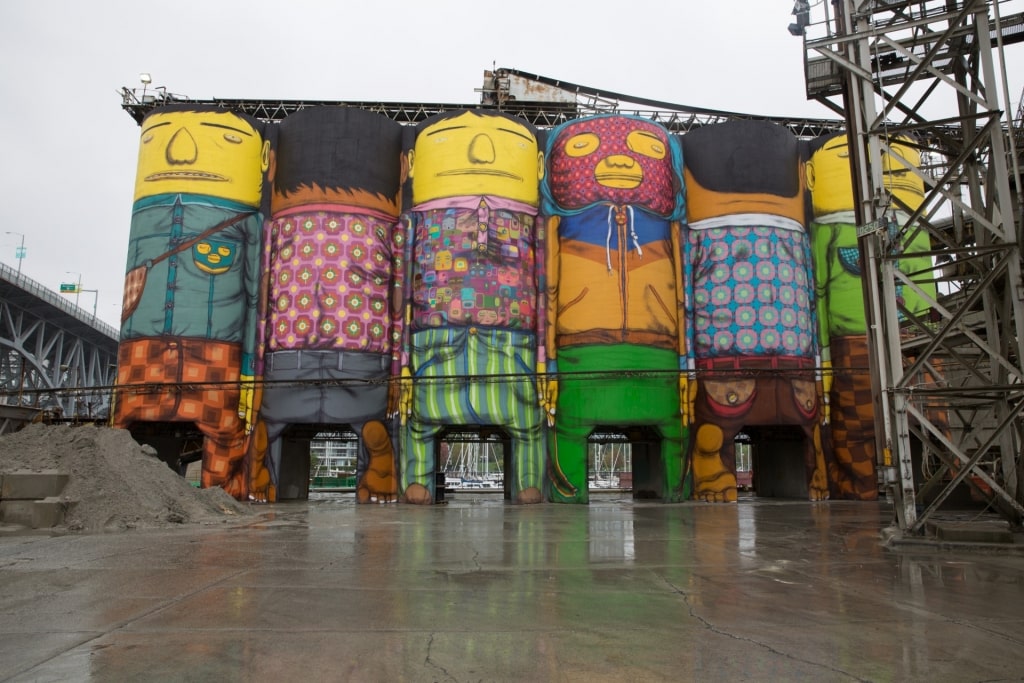
Giants in Vancouver, Canada
In 2014, a former industrial landmark on Granville Island, Vancouver was given a new lease of artistic life as part of the Vancouver Biennale.
Six industrial concrete silos were transformed by OSGEMEOS, the artistic moniker of two Brazilian-born twins, Otavio Pandolfo and Gustavo Pandolfo, into 70-foot-high Giants.
Eager to expand their murals from the previous two-dimensional style, the artists personally chose the weathered industrial setting to bring curvature to their creations. The six Giants, each dominating the full height of a silo, are dressed head to toe in colorful patterns, which allowed the twins to showcase their passion for bright designs.
As with most pieces created as part of the Biennale’s “Open-Air Museum”, Giants was intended to be a temporary installation. And while, for now, they still stare down on False Creek, these famous murals should be visited sooner rather than later.
San Gennaro Mural, Naples, Italy
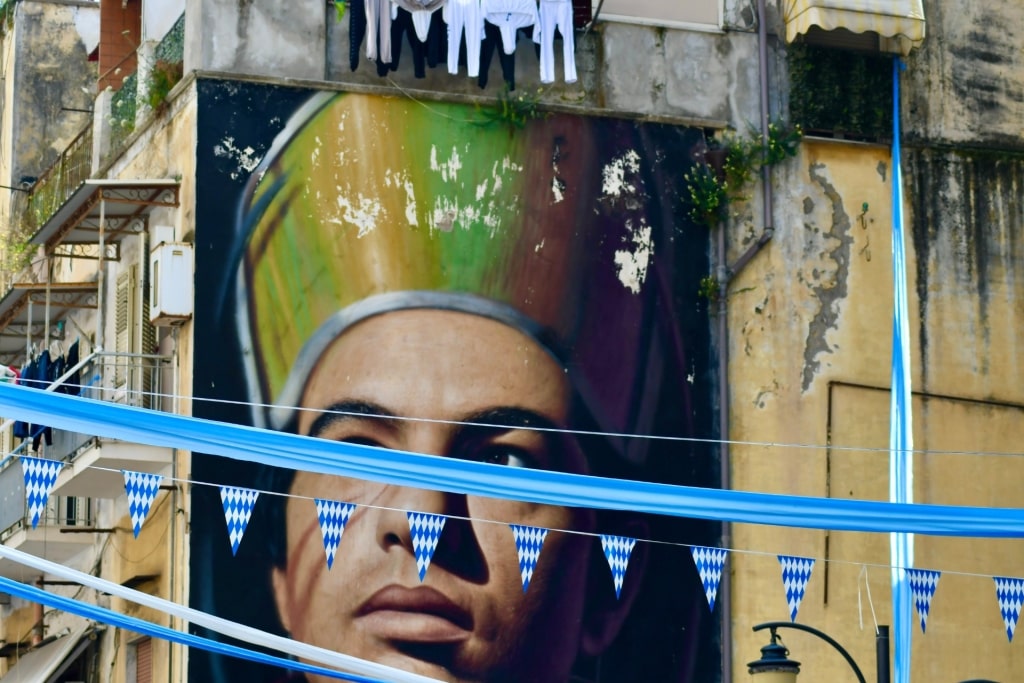
San Gennaro Mural in Naples, Italy
Internationally, Naples might be most famous for giving the world pizza. But locally, the city’s residents are equally devoted to their patron saint, San Gennaro.
Since 2015, the pensive face of the martyred bishop has taken prime place in Forcella, one of Naples’ oldest districts, thanks to Jorit Agoch’s nearly 50-foot-high mural.
However, far from being a typical saintly depiction, Agoch, as with much of his other work, decided to show a more modern, human side of San Gennaro. Instead, the impeccably detailed mural (the artist sometimes cites Italian painter Caravaggio as an inspiration) shows San Gennaro as a local worker.
Carnival Nymph, San Nicolas, Aruba
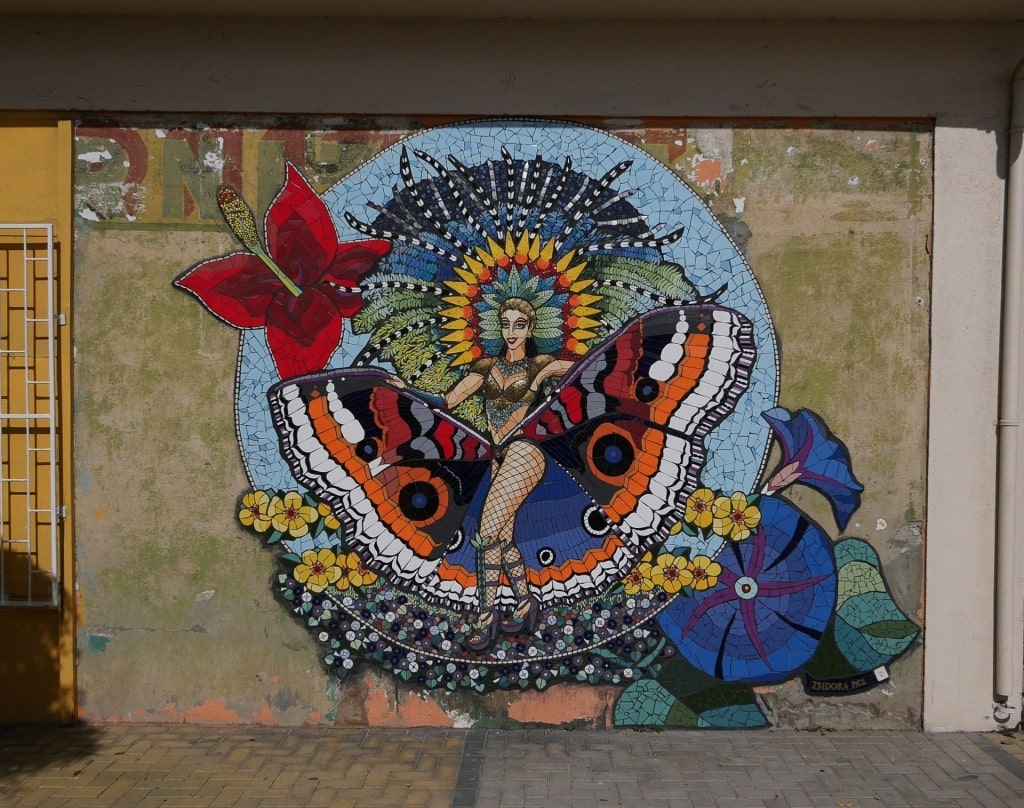
Carnival Nymph in San Nicolas, Aruba Photo by Jay Galvin on Flickr, licensed under CC BY 2.0
San Nicolas, Aruba’s second city, was once best known as the island’s red light district. Yet, keen to shake off the negative perception of visitors who would avoid the southern city, a passionate team of local creatives set about literally re-painting the narrative.
The result was an explosion of color, carnival events, and creative pop-ups. Nowadays, highly intricate murals and installations by street artists from the USA and Europe adorn nearly every once-forgotten corner.
Yet, even with all the international attention that has followed, one of the first and most famous murals remains Carnival Nymph by Chilean artist Isidora López Paz, whose work, mainly with mosaics, utilizes her background in ceramics.
For her Aruba installation, Paz managed to capture much of Aruba’s culture in small pieces of stone. The nation’s flag forms the background and Aruba’s pretty national flower, the yellow Wanglo, decorates the bottom of the circular wall art. In the middle, with a butterfly-style dress, a carnival dancer smiles back—a reminder of what awaits visitors to the “One Happy Island”.
Read: Best Places to Visit in Aruba
Crack is Wack, New York City, USA
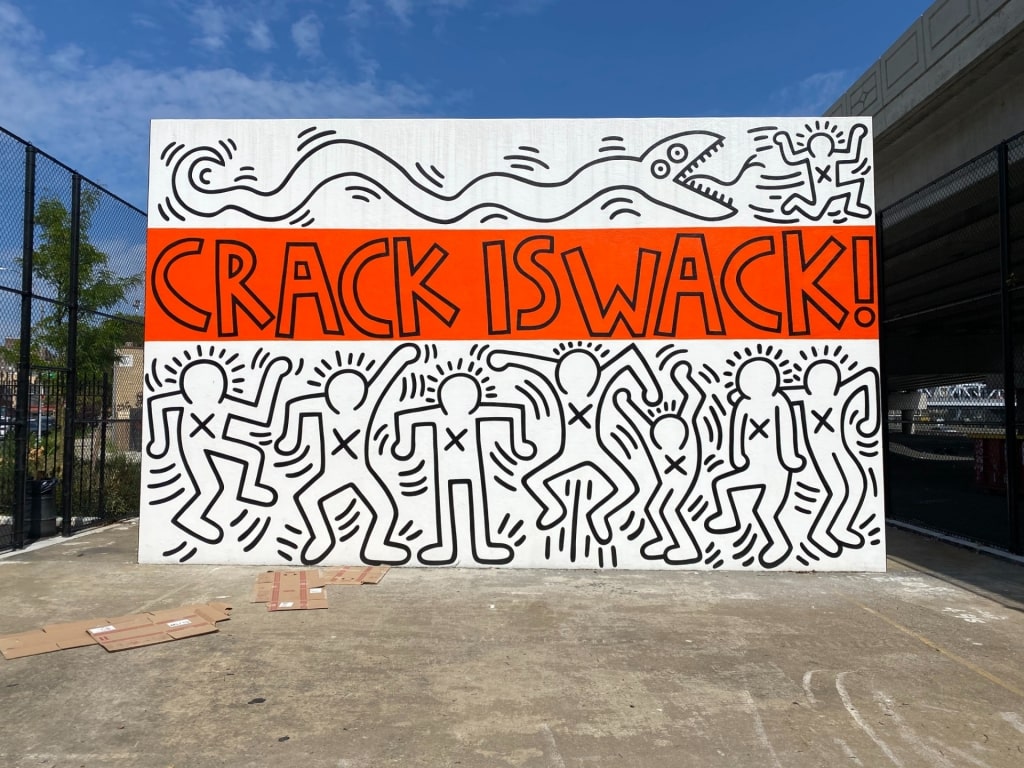
Crack is Wack in New York City, USA Photo by TheTurducken on Flickr, licensed under CC BY 2.0
Keith Haring’s Crack is Wack is one of New York’s oldest and most famous street art examples, making it a right of passage for mural-lovers when visiting The Big Apple.
Painted in 1986, at the height of the city’s drug epidemic, the artwork’s text and placement saw the iconic pop art creative arrested. Yet, the mural managed to survive in place next to a playground on Harlem River Drive, and has since been repainted using funds from the foundation established in the artist’s name.
Simple, in both its double-sided key message and depictions of figures alongside the image of a skull and bones, it remains one of the city’s most prominent murals even after 40 years. It’s a true legacy of Harring, renowned, both in life and death, for his social and political installations.
Piedra Negra, Haji Lane, Singapore
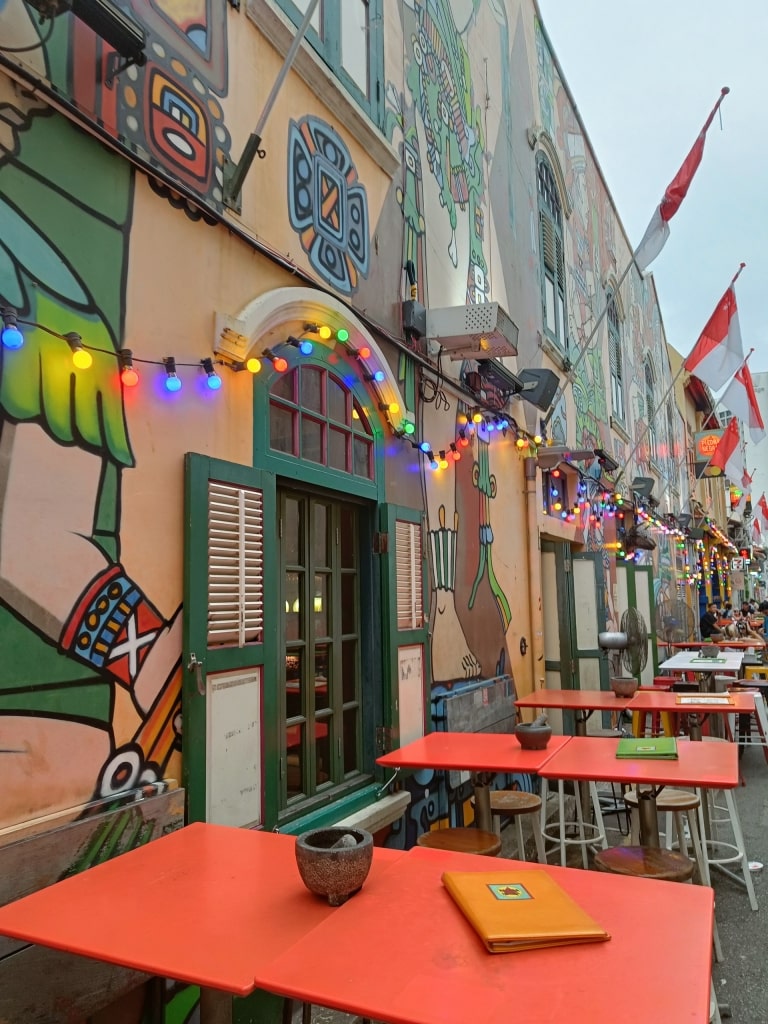
Piedra Negra in Haji Lane, Singapore Photo by Techwizzie on Wikimedia Commons, licensed under CC BY-SA 4.0
Singapore’s sleek skyscrapers, penchant for rules and order, and futuristic architecture might not seem a likely playground for the world’s best graffiti artists. Yet, away from the sterile Singapore CBD, Haji Lane has flourished as a kaleidoscopic corner of creativity.
One of the city’s most famous murals, and the first to brighten this pocket of the Kampong Glam neighborhood, can be found on the front of Piedra Negra, a longstanding Mexican restaurant.
Designed and painted by Colombian-born Didier Jaba Mathieu, the mural, depicting Mexican culture pre-colonization, was commissioned by the restaurant itself. With bold and vivid imagery of Indigenous outfits and Aztec symbols, Mathieu’s mural adds pieces of South America to one of Asia’s most contemporary cities.
His work also set the stage for many other businesses along Haji Lane to commission their own art works, and now the whole street is a colorful open-air gallery where delicious dishes are served against the backdrop of storied facades.
Read: Best Cities for Art in the World
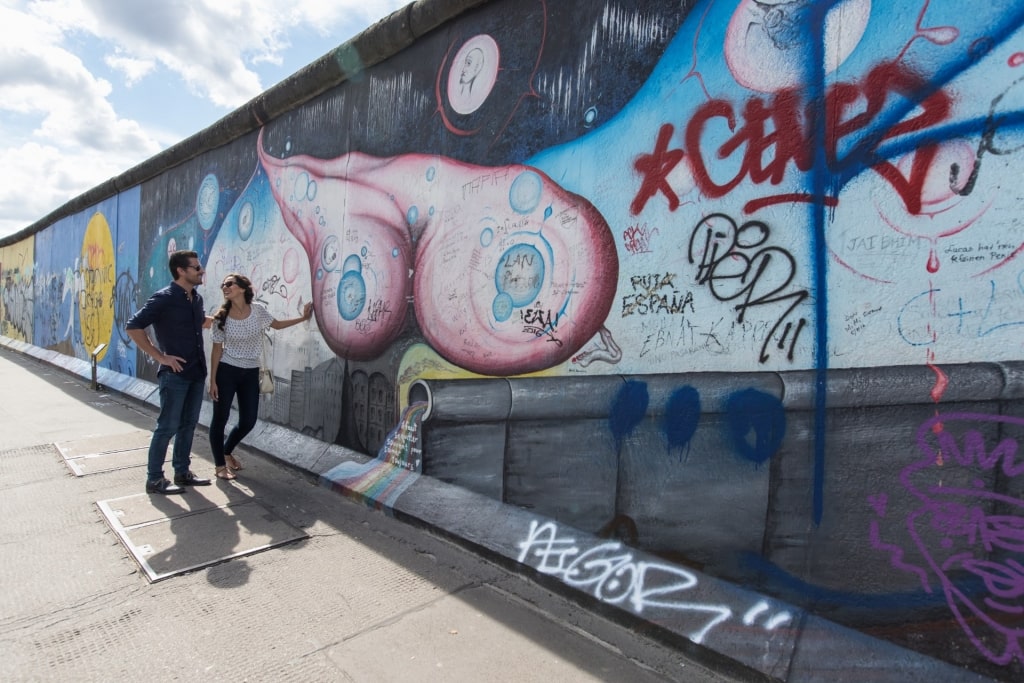
Berlin Wall, Germany
Eager to explore the world’s most famous street art on vacation? Browse Celebrity’s exciting worldwide itineraries here and start planning your next art-inspired getaway.
